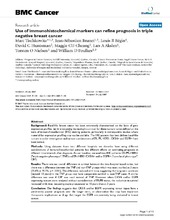Use of immunohistochemical markers can refine prognosis in triple negative breast cancer
Tischkowitz, Marc; Brunet, Jean-Sébastien; Bégin, Louis R.; Huntsman, David G.; Cheang, Maggie C. U.; Akslen, Lars A.; Nielsen, Torsten O.; Foulkes, William D.
Peer reviewed, Journal article
Permanent lenke
https://hdl.handle.net/1956/2629Utgivelsesdato
2007-07-24Metadata
Vis full innførselSamlinger
Originalversjon
https://doi.org/10.1186/1471-2407-7-134Sammendrag
Background: Basal-like breast cancer has been extensively characterized on the basis of gene expression profiles, but it is becoming increasingly common for these tumors to be defined on the basis of immunohistochemical (IHC) staining patterns, particularly in retrospective studies where material for expression profiling may not be available. The IHC pattern that best defines basal-like tumors is under investigation and various combinations of ER, PR, HER2-, CK5/6+ and EGFR+ have been tested. Methods: Using datasets from two different hospitals we describe how using different combinations of immunohistochemical patterns has different effects on estimating prognosis at different time intervals after diagnosis. As our baseline, we used two IHC patterns ER-/PR-/HER2- ("triple negative phenotype", TNP) and ER-/HER2-/CK5/6+ and/or EGFR+ ("core basal phenotype", CBP). Results: There was no overall difference in survival between the two hospital-based series, but there was a difference between the TNP and non-TNP groups which was most marked at 3 years (76.8% vs 93.5%, p < .0001). This difference reduced with time, suggesting that long term survivors (beyond 10 years) in the TNP group may have comparable survival to non-TNP cases. A similar difference was seen if CBP was used instead of TNP. However when CK5/6 and/or EGFR expressing tumors were analyzed without consideration of ER/PR status, the reduction in survival increased with time, becoming more pronounced at 10 years than at 3 years. Conclusion: Our findings suggests that CK5/6 and/or EGFR expressing tumor types have a persistently poorer prognosis over the longer term, an observation that may have important therapeutic implications as drugs that target the EGFR are currently being evaluated in breast cancer.
